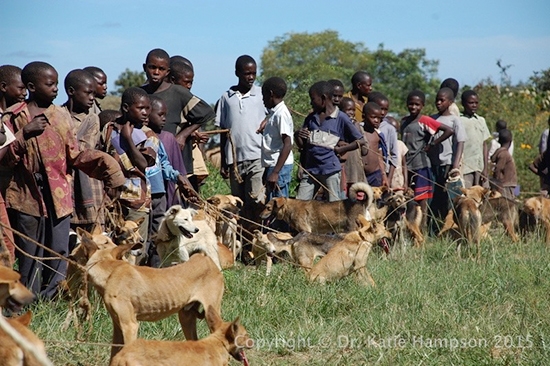New global study quantifies the cost of untreated rabies

African boys wait in line with dogs for vaccinations.
A global study on canine rabies, published April 16 in PLOS Neglected Tropical Diseases, estimates that globally canine rabies causes approximately 59,000 human deaths, over 3.7 million disability-adjusted life years (the number of years lost due to ill-health, disability, and early deaths), and $8.6 billion dollars in economic losses annually.
The study found that the greatest risk of canine rabies is in the poorest countries, with death rates (deaths per 100,000 people) highest in countries in sub-Saharan Africa. India has the highest number of fatalities, with over 20,000 human deaths annually.
The proportion of dogs vaccinated is far below that necessary to control the disease across almost all countries of Africa and Asia.
To provide some perspective, according to the World Animal Health Information Interface (WAHID), in 2013, the number of veterinarians and paraveterinarians in the United States was 222,952. In the Democratic Republic of the Congo, which is roughly one-third the size of the United States, the number was only 3,290.
Interestingly enough, in India, the number of veterinary professionals in 2013 was 70,767. Given that India is roughly one-third the size of the United States, it is unclear whether that high fatality rate is due to economics, education, or political agendas.
"I do think that the major barrier in places like India is the lack of political will (and therefore financial commitment) to control rabies at the source," Louise Taylor, Partners for Rabies Prevention Coordinator and Newsletter Editor at the Global Alliance for Rabies Control, told NEWStat.
"We know that canine rabies can be controlled if the investment is made in a national control strategy, but long term commitment is required to achieve success."
Given that, the current study may help reduce blockades to rabies eradication.
“This ground-breaking study is an essential step towards improved control and eventual elimination of rabies,” said Professor Louis Nel, Executive Director of the Global Alliance for Rabies Control (GARC).
“An understanding of the actual burden helps us determine and advocate for the resources needed to tackle this fatal disease.”
Led by Katie Hampson, PhD, an epidemiologist at the University of Glasgow, the study is the first to estimate the impact of canine rabies and the extent of control efforts in every country in the world.
“The breadth of data used in this study, from surveillance reports to epidemiological study data to global vaccine sales figures, is far greater than ever analyzed before, allowing this more detailed output,” said Hampson.
According to the report, collaboration between the human and animal health sectors can significantly reduce the burden on vulnerable economies. Indeed, the countries that have invested most in dog vaccination are the ones where human deaths from the disease have been virtually eliminated.
Photo Copyright © 2015 Katie Hampson, provided courtesy of Global Alliance for Rabies Control



